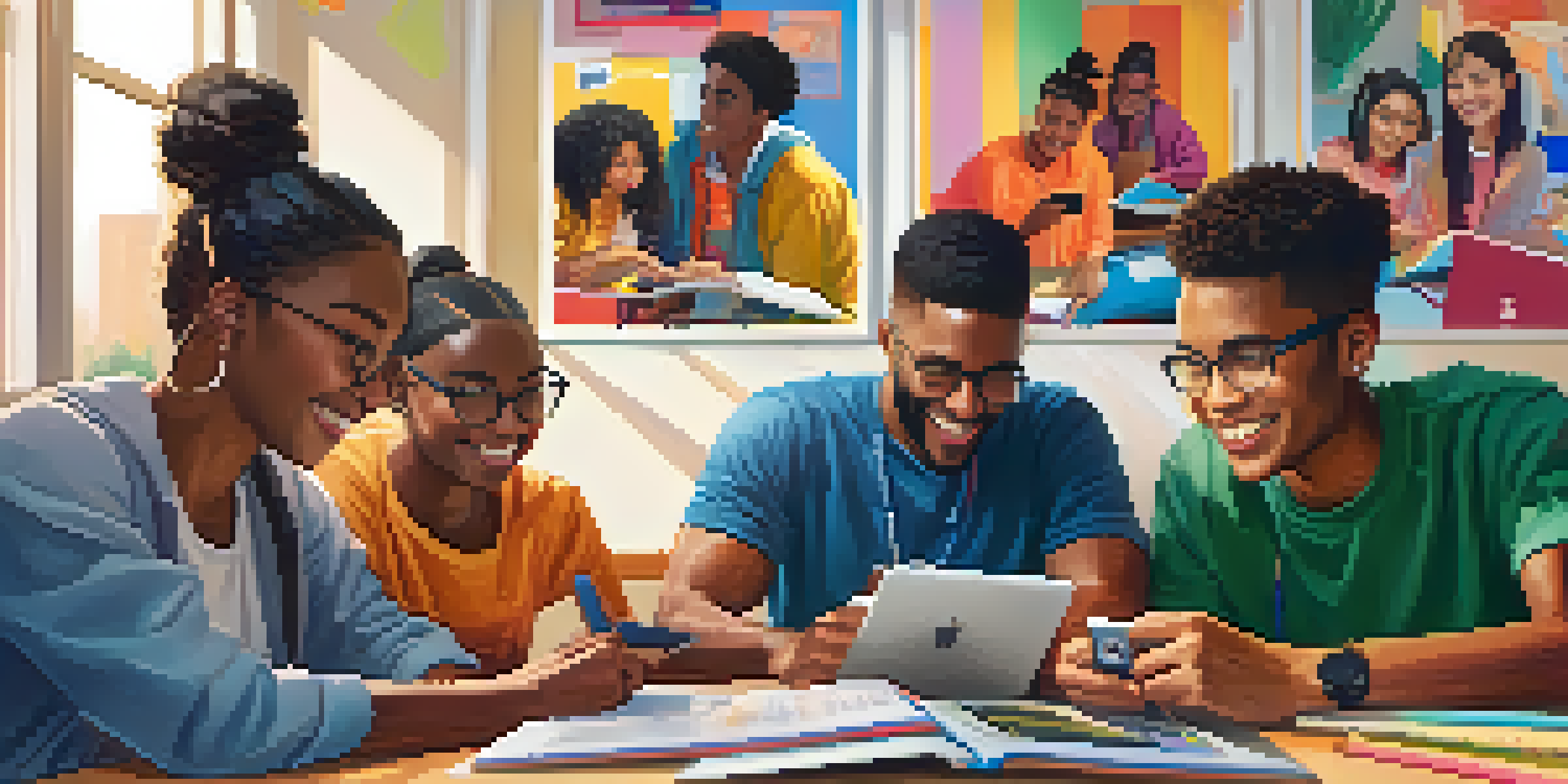How Mobile Devices Influence Peer Learning Opportunities

Understanding Peer Learning in a Digital Age
Peer learning refers to the process where individuals learn from each other, often in informal settings. In today's digital world, this concept has evolved, largely due to the prevalence of mobile devices. These devices allow learners to connect and collaborate seamlessly, breaking down geographical barriers and fostering a sense of community.
The beautiful thing about learning is that no one can take it away from you.
Imagine a study group that can meet anytime, anywhere, thanks to group chats and video calls on mobile apps. This flexibility not only enhances engagement but also encourages diverse perspectives, enriching the learning experience. It’s like having a classroom in your pocket, where your peers are just a tap away!
However, it's essential to note that while mobile devices facilitate peer learning, they can also introduce distractions. Striking a balance between using these tools for learning and avoiding non-educational distractions is crucial for maximizing their potential.
Access to a Wealth of Resources
One significant advantage of mobile devices is the easy access to a plethora of educational resources. From online articles to instructional videos, learners can find information on virtually any topic at their fingertips. This availability allows peers to share resources with each other quickly, enhancing collaborative learning.

Consider a scenario where a student doesn't understand a concept taught in class. They can quickly search for supplementary materials or tutorials on their mobile device and share them with classmates who might also be struggling. It’s this kind of resource-sharing that fosters an environment where everyone can learn from each other’s discoveries.
Peer Learning in a Digital World
Mobile devices facilitate peer learning by connecting individuals and enabling collaboration regardless of location.
Furthermore, with social media platforms and educational apps, peer learning has become even more interactive. Learners can engage in discussions or ask questions in real-time, making the learning process more dynamic and responsive.
Encouraging Collaboration and Communication
Mobile devices have revolutionized how peers communicate and collaborate on projects. With tools like messaging apps and collaborative documents, group work can proceed smoothly, even when members are miles apart. This ease of communication is vital in ensuring that everyone stays on the same page.
Collaboration allows us to know more than we are capable of knowing by ourselves.
For instance, a group project can be managed through shared documents on a mobile app, where each member contributes in real-time. This not only makes the process more efficient but also fosters a sense of ownership and accountability among peers. It’s akin to being part of a team where everyone plays a crucial role, regardless of their location.
Moreover, the ability to communicate instantly allows for quick feedback and brainstorming sessions, enhancing the quality of the work produced. This instant connectivity creates a culture of collaboration that benefits all involved.
Fostering Inclusivity and Diversity
One of the remarkable aspects of mobile devices is their ability to bring together diverse groups of learners. This inclusivity can lead to richer discussions and varied perspectives, enhancing the overall learning experience. When peers from different backgrounds collaborate, the learning becomes multifaceted and more relatable.
For example, international students can connect with local peers through mobile platforms, sharing their unique insights and cultural perspectives. This exchange not only broadens horizons but also fosters empathy and understanding, critical skills in today’s interconnected world.
Resources at Your Fingertips
Access to educational materials and social platforms enhances collaborative learning through easy resource sharing.
However, it's important to ensure that all voices are heard in these discussions. Encouraging quieter members to share their thoughts can promote a more balanced dialogue, leading to a deeper understanding of the subject matter.
Utilizing Educational Apps for Peer Learning
Educational apps have emerged as powerful tools for enhancing peer learning. Many of these apps facilitate collaborative learning through interactive games, quizzes, and shared resources. They provide a platform where learners can engage with each other while honing their skills.
Take language learning apps, for instance. These often include features that allow users to practice with peers, offering a fun and interactive way to learn. This gamified approach not only makes learning enjoyable but also encourages teamwork and friendly competition among peers.
As learners use these apps, they can provide feedback to one another, enhancing their understanding and retention of the material. This peer-to-peer interaction is a vital component of effective learning, making the experience more memorable.
Enhancing Accountability and Motivation
Mobile devices can significantly boost accountability among peers in a learning environment. With the ability to set reminders, track progress, and share achievements, learners can encourage each other to stay on task. This peer accountability fosters a sense of commitment to their collective goals.
For instance, a study group might create a shared calendar on their mobile devices, marking deadlines and meeting times. This not only helps everyone stay organized but also builds a culture of mutual respect and responsibility. It’s like having a personal coach cheering you on to reach your goals.
Balancing Benefits and Challenges
While mobile devices offer significant advantages for peer learning, they also present challenges like distractions and communication issues.
Moreover, the motivation derived from peer support can be a game changer. When learners see their peers making progress, it can inspire them to push through challenges and celebrate their successes together, creating a positive feedback loop.
Challenges of Mobile Devices in Peer Learning
While mobile devices offer numerous benefits for peer learning, they also come with their fair share of challenges. Distractions from social media or games can easily derail focus, making it crucial for learners to practice self-discipline. Understanding this balance is key to making the most of these tools.
Another challenge is the potential for miscommunication. Texting and messaging lack the non-verbal cues present in face-to-face interactions, which can lead to misunderstandings. Learners must be mindful of how they convey their thoughts and ensure clarity in their communications.

Lastly, not all learners may have equal access to mobile technology, creating disparities in participation. Addressing these inequalities is essential for fostering an inclusive peer learning environment, ensuring that everyone has the opportunity to engage and contribute.